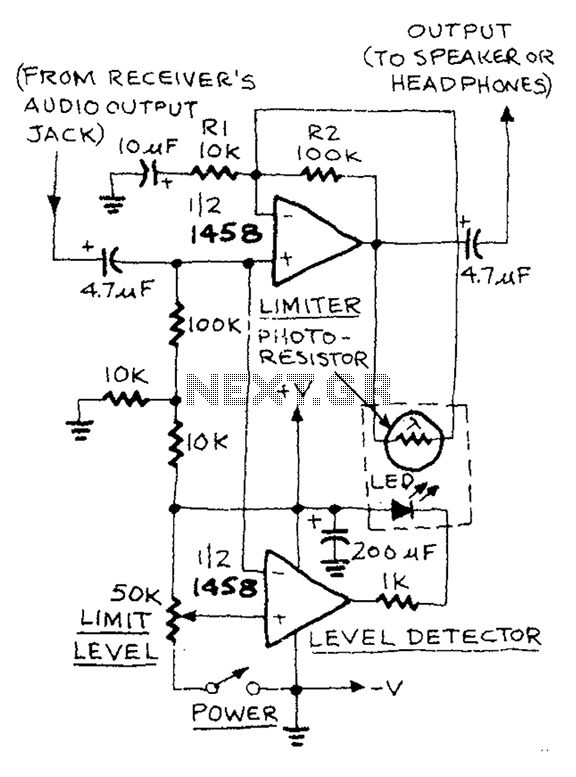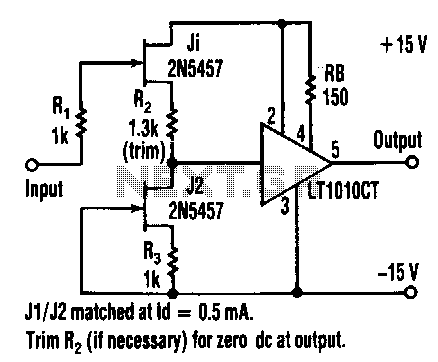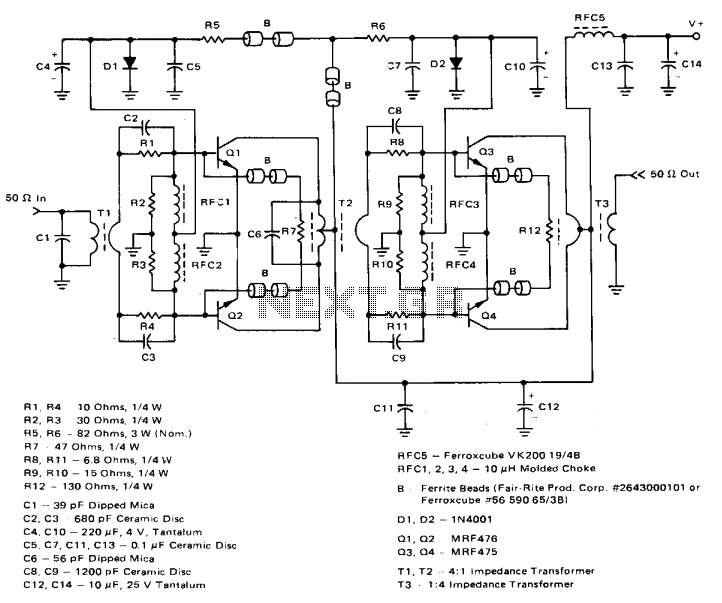
Low-Distortion Amplifier/Compressor

Designers can construct a 15-dB compressor using a miniature lamp and a current-feedback amplifier. The circuit exhibits extremely low distortion at frequencies above the lamp's thermal time constant, indicating that distortion remains negligible from audio frequencies to over 10 MHz. Additionally, there is minimal variation in phase relative to gain compared to other automatic gain-control circuits. Consequently, the circuit is suitable for various applications in instrumentation, audio, and high-frequency domains due to its low distortion and minimal phase change. The AD844 operational amplifier is ideal for this application as it functions as a current-feedback amplifier. Each stage of the circuit, including U2, the lamp, and the feedback resistor, compresses an AC signal by more than 15 dB. Cascading multiple stages can achieve higher compression ranges. The op amp U1 serves as a unity-gain buffer to drive the compressor's input, although it can be omitted if a low-impedance signal source is utilized. The resistance of the lamp increases with temperature, which decreases the ratio of resistor R3 to the lamp's resistance, thereby reducing the gain of U2. For optimal performance, the lamp's cold resistance should exceed the input resistance of U2 (greater than 50 ohms). The lamp's resistance will slightly vary at low input levels, ensuring that the ratio of R3 to the lamp's resistance and the gain of U2 remains elevated.
The described circuit functions as a dynamic range compressor, which is a critical component in audio processing and signal conditioning applications. The use of a miniature lamp as a variable resistor introduces a unique mechanism for controlling gain in response to signal amplitude. The current-feedback nature of the AD844 op amp allows for high-speed operation and low distortion, which is essential for maintaining audio fidelity across a wide frequency range.
In practical implementation, the circuit can be arranged such that the miniature lamp is thermally coupled to the environment, allowing it to respond dynamically to changes in signal power. This thermal response is crucial, as it dictates the time constant for the lamp's resistance change, ensuring that the compressor reacts appropriately to transient signals without introducing significant distortion.
The cascading of multiple stages enables designers to tailor the compression characteristics to fit specific applications. Each additional stage contributes to a more pronounced compression effect, allowing for fine-tuning of the overall gain reduction. The optional buffer stage (U1) is a strategic choice, as it can either isolate the compressor from the preceding circuit or enhance performance by driving the input with a stable, low-impedance signal.
The careful selection of components, particularly the lamp and feedback resistor, plays a vital role in the circuit's performance. The lamp's cold resistance must be adequately specified to ensure compatibility with the op amp's input characteristics. Furthermore, the feedback resistor (R3) should be chosen to optimize the gain settings based on the application's requirements.
Overall, this circuit design exemplifies a sophisticated approach to audio signal processing, leveraging the unique properties of a current-feedback amplifier and a thermally responsive element to achieve effective gain control with minimal distortion. Such a configuration is invaluable in professional audio equipment, broadcast systems, and instrumentation where signal integrity is paramount. Designers can build a 15-dB compressor with a miniature lamp and a current-feedback amplifier. The circ uit possesses extremely low distortion at frequencies above the lamp"s thermal time constant. This means that distortion is negligible from audio frequencies to beyond 10 MHz. There"s also relatively little change in phase versus gain compared to other automatic gain-control circuits. Lastly, the circuit has many instrumentation, audio, and high-frequency applications as a result of its low distortion and small phase change.
The AD844 op amp is a perfect fit for this application because it"s a current-feedback amplifier. Each stage of the circuit, U2, lamp, and feedback resistor compresses an ac signal by over 15 dB (see the figure). Cascading a number of stages delivers higher compression ranges. Op amp U1 operates as a unity-gain buffer to drive the input to the compressor. However, U1 is optional if a low-impedance signal source is used. The lamp"s resistance will increase with temperature, which reduces the ratio of resistor R3 to the resistance of the lamp.
This ratio reduces the gain of U2. The lamp"s cold resistance should be greater than the input resistance of U2 (more than 50 ) for proper operation. The lamp"s resistance will change slightly for low input levels. Therefore, the ratio of R3 to the resistance of the lamp and the gain of U2 stays high. 🔗 External reference
The described circuit functions as a dynamic range compressor, which is a critical component in audio processing and signal conditioning applications. The use of a miniature lamp as a variable resistor introduces a unique mechanism for controlling gain in response to signal amplitude. The current-feedback nature of the AD844 op amp allows for high-speed operation and low distortion, which is essential for maintaining audio fidelity across a wide frequency range.
In practical implementation, the circuit can be arranged such that the miniature lamp is thermally coupled to the environment, allowing it to respond dynamically to changes in signal power. This thermal response is crucial, as it dictates the time constant for the lamp's resistance change, ensuring that the compressor reacts appropriately to transient signals without introducing significant distortion.
The cascading of multiple stages enables designers to tailor the compression characteristics to fit specific applications. Each additional stage contributes to a more pronounced compression effect, allowing for fine-tuning of the overall gain reduction. The optional buffer stage (U1) is a strategic choice, as it can either isolate the compressor from the preceding circuit or enhance performance by driving the input with a stable, low-impedance signal.
The careful selection of components, particularly the lamp and feedback resistor, plays a vital role in the circuit's performance. The lamp's cold resistance must be adequately specified to ensure compatibility with the op amp's input characteristics. Furthermore, the feedback resistor (R3) should be chosen to optimize the gain settings based on the application's requirements.
Overall, this circuit design exemplifies a sophisticated approach to audio signal processing, leveraging the unique properties of a current-feedback amplifier and a thermally responsive element to achieve effective gain control with minimal distortion. Such a configuration is invaluable in professional audio equipment, broadcast systems, and instrumentation where signal integrity is paramount. Designers can build a 15-dB compressor with a miniature lamp and a current-feedback amplifier. The circ uit possesses extremely low distortion at frequencies above the lamp"s thermal time constant. This means that distortion is negligible from audio frequencies to beyond 10 MHz. There"s also relatively little change in phase versus gain compared to other automatic gain-control circuits. Lastly, the circuit has many instrumentation, audio, and high-frequency applications as a result of its low distortion and small phase change.
The AD844 op amp is a perfect fit for this application because it"s a current-feedback amplifier. Each stage of the circuit, U2, lamp, and feedback resistor compresses an ac signal by over 15 dB (see the figure). Cascading a number of stages delivers higher compression ranges. Op amp U1 operates as a unity-gain buffer to drive the input to the compressor. However, U1 is optional if a low-impedance signal source is used. The lamp"s resistance will increase with temperature, which reduces the ratio of resistor R3 to the resistance of the lamp.
This ratio reduces the gain of U2. The lamp"s cold resistance should be greater than the input resistance of U2 (more than 50 ) for proper operation. The lamp"s resistance will change slightly for low input levels. Therefore, the ratio of R3 to the resistance of the lamp and the gain of U2 stays high. 🔗 External reference


